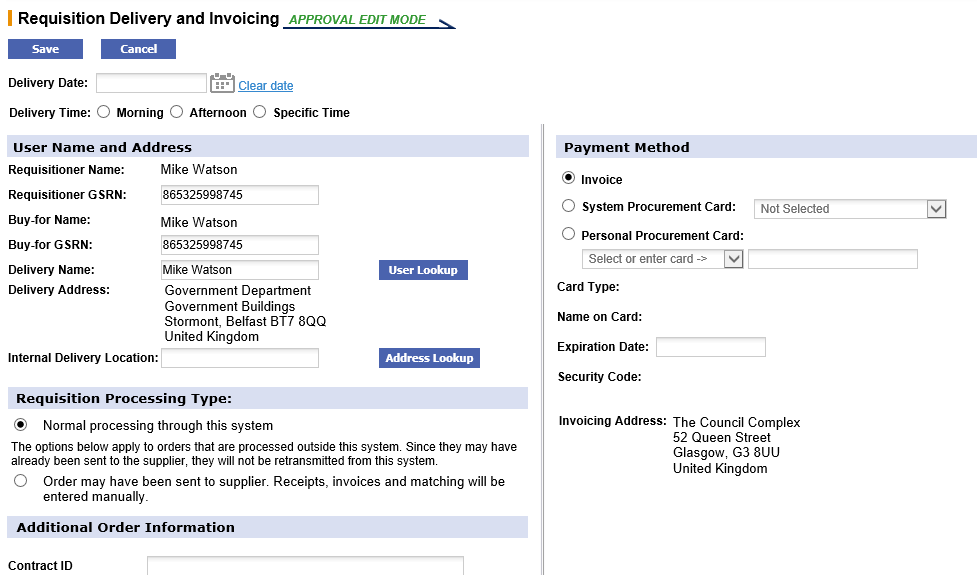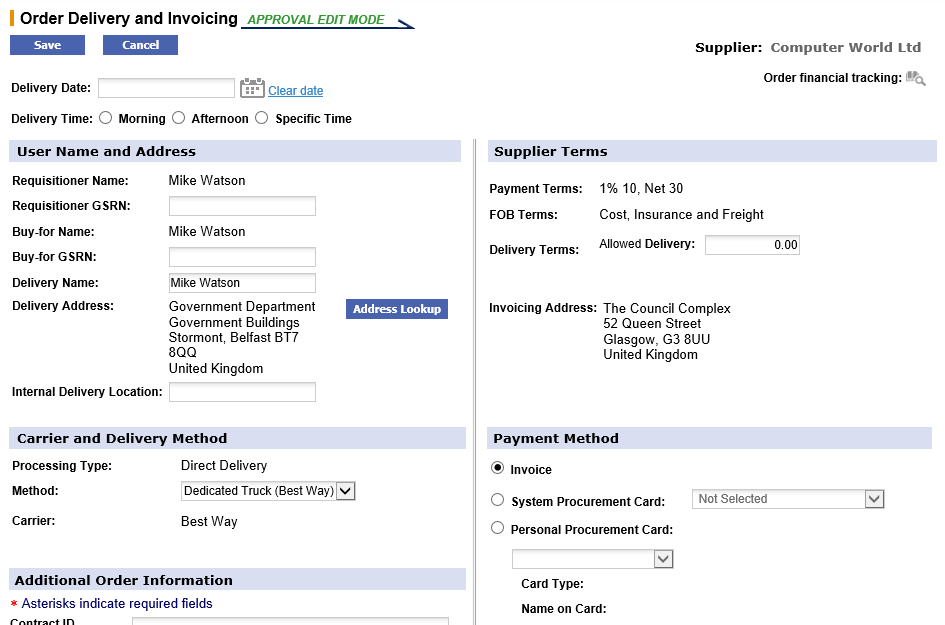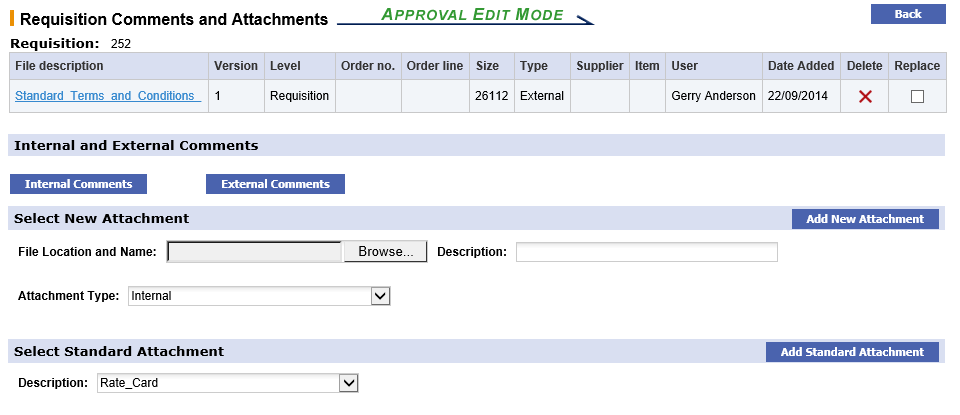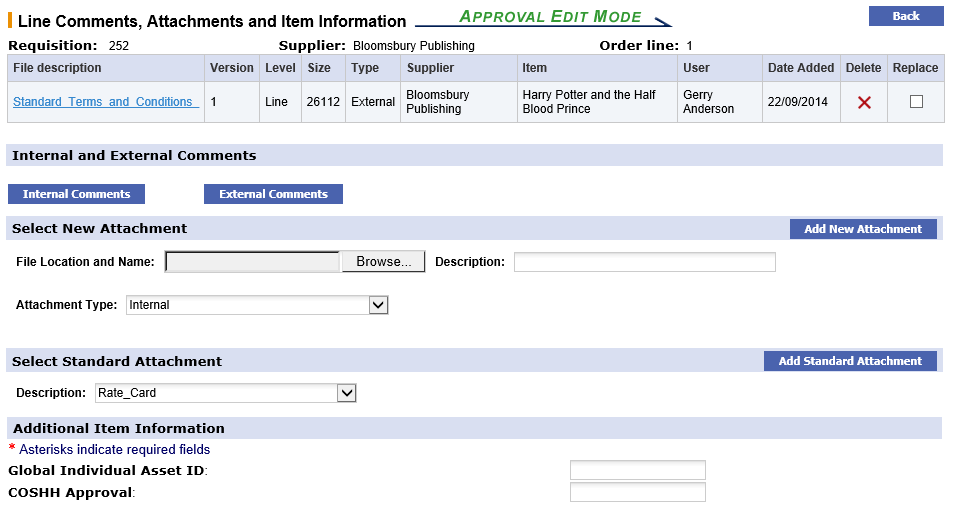General Actions:
PECOS Approval » 5. Approving Requisitions and Order Requests » 5.5 Edit Requisitions and Orders » 5.5.1 Editing Requisitions
5.5.1 Editing Requisitions
In the Requisition Approval Summary screen click on the ‘Edit’ button to open the ‘Requisition - Approval Edit Mode’ screen.
Whilst in edit mode the following actions can be performed:
- Change Item Quantities. Change item quantities by over-typing the existing quantity in the ‘Qty’ column. Ensure you tab out of the box after typing to allow the document to refresh and update.
The following configuration must be taken into consideration when updating item quantities:- Decimal quantities. Check whether decimals are allowed for your organisation.
- Minimum Order quantities. It will not be possible to reduce a quantity below the item’s minimum order quantity. If you do so, an error message will display.
- Maximum Order Quantity. It will not be possible to increase a quantity above the item’s maximum order quantity. If you do so, an error message will display.
- Add Catalogue Items. Add items in the normal way: navigate to the Item Search screen; use the Quick Search at the top of the screen; or use ‘Direct Item Entry’ at the foot of the requisition. You will be able to add items from any catalogue according to your requisitioning and supplier access privileges.
- Requisition Delivery and Invoicing information. Click on the ‘Requisition Delivery and Invoicing’ link at the top of the document.

From here the following information can be changed for the whole requisition:- Change Buy-for details by clicking the ‘User Lookup’ button. Buy-for user details can only be changed at requisition level and will be applied to all orders.
- Add or change the Requisitioner or Buy-for User's GSRN.
- Change the Delivery Address by clicking the ‘Address Lookup’ button.
- Add or change the Internal Delivery Location by editing the text box.
- Edit any Additional Order Information. These boxes will be either text boxes or drop down list boxes, depending on how your system administrator has defined them.
- Add or change the Delivery Date by clicking on the calendar icon. Note that the delivery date may be configured for mandatory completion, in which case it must be changed and not cleared.
- Add or change the Delivery Time by selecting the appropriate radio button.
- Change the Payment Method and optionally select procurement card details.
- Change Requisition Processing Type by selecting an alternate radio button.Change Buy-for details by clicking the ‘User Lookup’ button. Buy-for user details can only be changed at requisition level and will be applied to all orders.
- Order Delivery and Invoicing Information. To change Delivery and Invoicing details for an individual order, click on the ‘Order Delivery and Invoicing’ link at the top of the Order section.

From here the following information can be changed for the individual order:- Change the Delivery Address by clicking the ‘Address Lookup’ button.
- Add or change the Delivery Date and Time.. Note that the delivery date may be configured for mandatory completion, in which case it must be changed and not cleared.
- Add or change the Delivery Time by selecting the appropriate radio button.
- Add or change the Buy-for User's GSRN.
- Add or change the Internal Delivery Location by editing the text box.
- Change the Delivery Method by selecting an alternative from the drop down selection box. This will update on the purchase order.
- Edit any Additional Order Information. These boxes will be either text boxes or drop down list boxes, depending on how your system administrator has defined them.
- Optionally edit Payment and Delivery Terms, if your user permissions allow.
- Edit or enter estimated Allowed Delivery charges if displayed. Note that the value of estimated delivery will be included in the document total for approval routing purposes (it will not be added as an order line item).
- Indicate if the order is to be Tax Exempt by checking the ‘Tax Exempt' box if displayed.
- Change the Payment Method and optionally select procurement card details.
- Comments and Attachments. Add or update attachments and comments by clicking on the paperclip icon. Comments and attachments can be updated at one of three levels: requisition, order and line.
- Requisition Level. Click the paperclip icon in the requisition header to open and edit comments and attachments applied to the whole requisition. These comments and attachments will apply to all orders in the requisition.

- Order Level. Click the paperclip icon in the order header to open and edit comments and attachments applied to an individual purchase order document.
- Line Level. Click the paperclip icon at line level to open and edit comments and attachments and also additional item information applied to the line item only.

- Requisition Level. Click the paperclip icon in the requisition header to open and edit comments and attachments applied to the whole requisition. These comments and attachments will apply to all orders in the requisition.
- Delete. Delete a line by clicking on the red delete icon on the line you wish to delete. All lines for an entire order can be deleted by clicking on the icon in the order summary line.
- Financial Tracking & VAT. Change financial tracking and VAT treatment details by clicking on the financial tracking icon at one of the following levels:
- Requisition level - to change details for the entire requisition.
- Order level - to change details for the entire order.
- Line level - to change details and optionally split charges for the line only.
- Add a Non-Catalogue item to the requisition by clicking on the ‘Add Non-Catalogue item’ button.
- Save Changes. When all changes have been made to your satisfaction, click on the ‘Return To Requisition Summary’ button to save your changes. The Requisition Approval Summary screen will once again be displayed.
Notice that the audit trail will have been updated for all of the changes that you have made.
To complete the editing action you have two options:
- Click ‘Approve’. The requisition will move forwards in the approval process to the next workflow step.
- Click ‘Return To Requisitioner’. Mandatory comments must be entered. The requisition will be returned to the requisitioner with an email message containing your comments. The requisition will not move forwards in the approval process but upon optional editing and resubmission by the requisitioner, will return to the start.
Navigation
P2P Approvals
